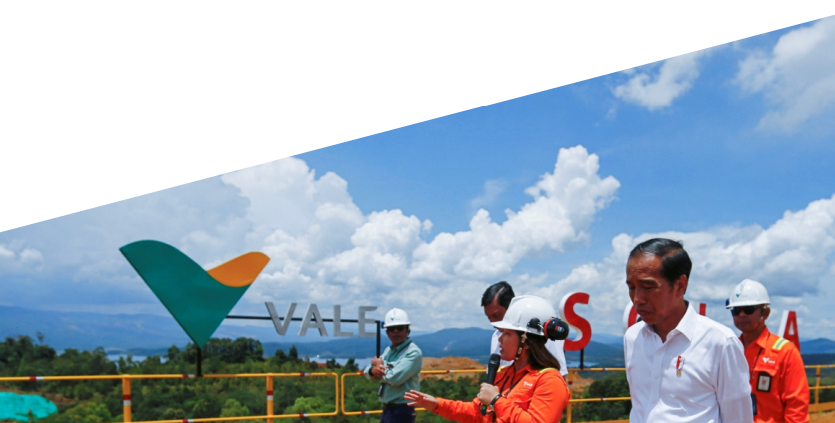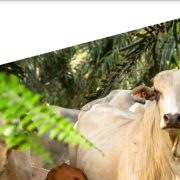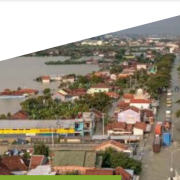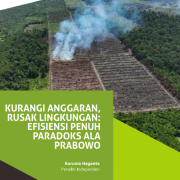Balancing The Scales: Indonesia’s Climate Justice and Human Rights Journey
In the midst of a profound global transformation sparked by the triple disruption – the digital revolution, the COVID-19 pandemic, and climate change – Indonesia stands at the forefront, grappling with the intricate dance between climate justice and human rights under the umbrella of the Paris Agreement. This Op-Ed will explore how Indonesia must adeptly respond to the Paris Agreement in line with the current climate conditions. It underscores the notion that the Paris Agreement encompasses more than just emission reduction, as articulated by its preamble, emphasizing the imperative to “respect, promote, and consider their respective obligations on human rights.” (UNFCCC, 2015)
The Paris Agreement transcends legal jargon; it’s a collective vow on a global stage to confront the urgent challenge of climate change. At its core, it’s a simple yet bold mission: keep the global temperature rise under 2 degrees Celsius, aiming for an even more ambitious 1.5 degrees Celsius, all to avoid the severe consequences of unchecked climate change. But this isn’t just about lofty goals; it’s a call for individual action. Each country, through Nationally Determined Contributions (NDCs), sets its own targets and plans to cut greenhouse gas emissions, tailoring efforts to its strengths. The commitment doesn’t stop there – countries must continually update and ramp up these plans.
The Paris Agreement recognizes the interconnectedness of climate change, human rights, and climate justice by emphasizing the importance of respecting, promoting, and considering human rights in the context of climate action. The Paris Agreement isn’t just a climate pact; it’s a bold declaration that climate action must go hand in hand with human rights. Let’s break it down. First off, it recognizes the need for a just transition for workers and creating decent jobs that align with each country’s development goals. Translation: climate efforts shouldn’t harm jobs and workers’ rights. Next, it encourages nations to consider their human rights obligations when tackling climate change – think of the right to life, health, and a safe environment. The Agreement gets real about the fact that climate change hits certain groups harder, like women, indigenous peoples, local communities, and vulnerable populations. It’s not just lip service; it urges us to safeguard their rights and include them in climate decisions. Plus, it puts a spotlight on adapting to climate change, making sure vulnerable communities get the support they need. Thus, we should all be in the loop, promoting public participation, awareness, and access to info – because fighting climate change is a collective effort.
When it comes to the Paris Agreement, Indonesia has a unique opportunity to highlight the invaluable contribution of indigenous communities in combating climate change. This was underscored during the 10th Facilitative Working Group (FWG) Local Communities and Indigenous People Platform (LCIPP) Road to UNFCCC COP28 meeting in Dubai, where Indonesia was recognized as a role model for community-based climate resilience, particularly among indigenous peoples. Since 2016, the Indonesian government has designated 131 Indigenous Forest Community (Hutan Adat) permits across 18 provinces and 40 districts, covering approximately 244,195 hectares and involving 76,079 households. In 2023 alone, an additional 23 Indigenous Forest Community permits were granted, covering 90,873 hectares, with an indicative total area of 836,141 hectares spread across 16 provinces (Ministry of Environment and Forestry of Indonesia, 2023). This is further reinforced by legislation such as UU No. 41 of 1999 on Forestry, which recognizes the existence of Indigenous Law Communities and their territories, designated through regional regulations.
So, how can indigenous communities help tackle climate change? These communities, safeguarding a significant 20.1% of the world’s tropical forest carbon, are unsung heroes in our climate battle. Research by the World Resources Institute (WRI) found that annual deforestation rates in indigenous forests in Bolivia, Brazil, and Colombia from 2000-2012 were two to three times lower than in similar forest areas not managed by indigenous peoples (World Resources Institute, 2021). It’s essential to recognize that these forests are more than just trees; they are homes, livelihoods, and identities for indigenous peoples. Alarmingly, nearly 80% of countries participating in the Paris Agreement fail to mention these crucial communities in their climate pledges. To effectively address climate change, Indonesia can lead by example by integrating the rights of indigenous communities into its climate action plans, starting with the Intended Nationally Determined Contributions (INDCs).
However, the current government’s commitments seem to be moving in the opposite direction. Recent government actions, such as those evident in the President’s August 2023 state address and the focus on nickel downstreaming, indicate a lack of understanding in managing the country’s potential. The President’s apparent disregard for ecological and climate crises is highlighted by the prioritization of the nickel downstreaming agenda. This focus has already resulted in damaging environmental and societal impacts, as seen in projects like the Indonesia Morowali Industrial Park and Harita Group’s nickel mine in various regions. Data from Walhi underscores the devastating consequences of nickel downstreaming on the natural landscape in Central and Southeast Sulawesi, South Sulawesi, and North Maluku (Alexander, 2023). By 2022, nickel mining concessions had covered over a million hectares, with a significant portion within forest areas.
The expansion of nickel downstreaming in Indonesia beyond land degradation poses severe environmental threats, including ocean and freshwater pollution, destruction of small islands, and disruption of ecosystems, as witnessed in the Konawe Islands, Southeast Sulawesi. This trend is further exacerbated by the government’s promotion of electric vehicles, which rely on nickel-intensive batteries, increasing the demand for nickel mining. However, the lack of robust environmental regulations and oversight raises concerns about sustainability and environmental degradation. Indigenous communities, often residing in resource-rich areas, bear the brunt of these activities, facing threats to their land rights, traditional livelihoods, and cultural heritage. Additionally, they suffer violations of their rights to a clean environment, access to clean water, and food security.
This unchecked expansion not only undermines climate adaptation efforts but also perpetuates social injustices and human rights violations. Indigenous communities, marginalized and often excluded from decision-making processes, disproportionately bear the adverse impacts of nickel mining. Ensuring sustainable resource management and respecting indigenous rights are crucial to addressing these challenges and fostering meaningful participation in decision-making. Failure to do so not only compromises environmental integrity but also perpetuates social inequalities and human rights abuses, threatening the well-being of present and future generations in Indonesia.
However, if the government wants to focus on potential economic activities while also aiding emission reduction, engaging indigenous people could be an attractive strategy because the economic benefits of protecting indigenous and community lands far outweigh the costs. The value of carbon sequestration and other ecosystem services from these lands is significantly higher than the costs to governments of securing land rights. For instance, over a 20-year period, the total economic benefits from indigenous lands amount to $54–119 billion for Bolivia, $523–1,165 billion for Brazil, and $123–277 billion for Colombia, with the total costs of securing these lands being at most 1% of the total benefits (World Resources Institute, 2021). Securing indigenous land for carbon sequestration proves to be a cost-effective climate mitigation approach, especially compared to other methods.
Furthermore, despite the push for nickel downstreaming, the Indonesian government should capitalize on our nation’s tropical nature and prioritize the down-streaming of agricultural commodities. For example, Indonesia boasts over 30 varieties of coffee, yet our economy is dominated by other nations like Singapore and Vietnam. Our true potential lies in crops like cloves, coffee, nutmeg, and more. As these plants thrive, so does the environment. It’s time to shift our focus away from the detrimental impact of mining and minerals on the economy of tropical nations. By embracing the potential of our rich agricultural landscape, we not only foster economic growth but also ensure a sustainable and flourishing environment.
Shifting focus from nickel downstreaming to agricultural commodities downstreaming presents significant advantages for indigenous communities in Indonesia. The government can create opportunities for indigenous peoples to engage in and benefit from agricultural activities. This approach not only leverages indigenous communities’ traditional knowledge and expertise but also provides sustainable livelihood options that are less environmentally harmful than mining. Promoting economic self-sufficiency and resilience among indigenous communities while preserving their cultural heritage and traditional practices is essential.
In conclusion, Indonesia stands at a critical juncture where strategic decisions can shape the nation’s future trajectory. Despite the current emphasis on nickel downstreaming, it’s imperative for the government to recognize the immense potential of indigenous communities in combating climate change and fostering sustainable development. By prioritizing the protection of indigenous and community lands, Indonesia can unlock significant economic benefits while mitigating emissions and preserving invaluable ecosystems. Moreover, the government must prioritize the well-being and rights of indigenous peoples in all decision-making processes, ensuring their meaningful participation and empowerment. This includes recognizing and respecting their land rights, preserving their traditional livelihoods, and safeguarding their environmental stewardship role. By doing so, Indonesia can not only fulfill its obligations under the Paris Agreement but also set a global example of inclusive and sustainable development.
In essence, the future of Indonesia on climate justice lies in embracing indigenous wisdom, protecting natural resources, and promoting sustainable practices that benefit both present and future generations. It’s time for Indonesia to chart a course towards a more equitable, resilient, and environmentally sustainable future.
References
Alexander, H. (2023). Pidato Jokowi tentang Hilirisasi Nikel, Walhi: Tak Peduli Krisis Iklim. Artikel. https://lestari.kompas.com/read/2023/08/17/220000286/pidato-jokowi-tentang-hilirisasi-nikel-walhi–tak-peduli-krisis-iklim?page=all#/: diakses pada 20 Februari 2024
Bagaskara. (2016). Mengenal Apa itu Paris Agreement dan Implementasinya di Indonesia. https://mutucertification.com/mengenal-paris-agreement-indonesia/ diakses pada 20 Februari 2024
Goodhart, Michael E. (1969). Human Rights and Comparative Politics. Oxford University Press, pp 77-92.
Ministry of Environment and Forestry of Indonesia. (2023). Indonesia menjadi role model ketahanan iklim berbasis masyarakat. https://ppid.menlhk.go.id/berita/siaran-pers/7522/indonesia-menjadi-role-model-ketahanan-iklim-berbasis-masyarakat diakses pada 21 Maret 2024
Saturi, S. (2016). Tandatangani Kesepakatan Paris, Tak Sekadar Komitmen, Indonesia Perlu Kerja Serius. https://www.mongabay.co.id/2016/04/25/tandatangani-kesepakatan-paris-tak-sekadar-komitmen-indonesia-perlu-kerja-serius/: diakses pada 20 Februari 2024
Schapper, A., & Lederer, M. (2014). Introduction: Human rights and climate change: mapping institutional inter-linkages. Cambridge Review of International Affairs, Vol. 27 (4) pp 666-679.
United Nations Framework Convention on Climate Change (UNFCCC). (2015). Paris Agreement.
World Resources Institute. (2021). 4 ways indigenous and community lands can reduce emissions. https://www.wri.org/insights/4-ways-indigenous-and-community-lands-can-reduce-emissions diakses pada 21 Maret 2024
.











Leave a Reply
Want to join the discussion?Feel free to contribute!